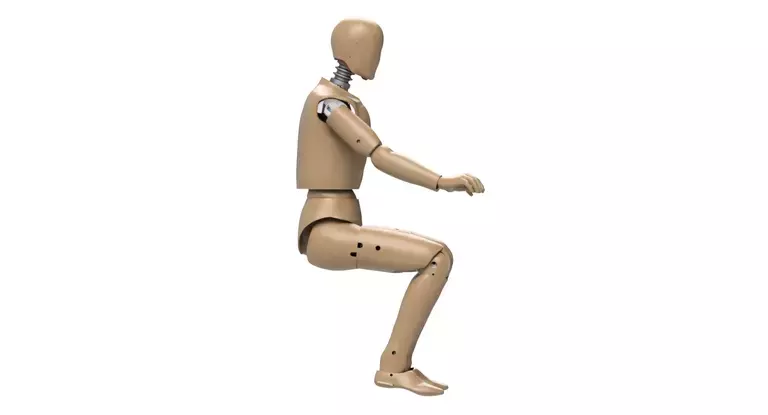





POWERED TWO-WHEELER DUMMY (PTW)
- Standard ATD 78051-0000-PTW
Powered Two and Three-Wheelers (PTWs) are a popular means of transport. Fully electric PTWs can be operated locally emission-free and, therefore, may support sustainable transport options. However, in terms of the safety offered to PTW riders there is still a long way to go compared with other means of transportation. As such, PTW riders are a vulnerable road user group that stands to benefit from improved protection. That’s why Humanetics has teamed up with Autoliv to develop a new crash test dummy, an ATD (Anthropometric Test Device), intended principally for use in testing PTWs, and facilitate evaluations of PTW protective systems. The end goal being to promote more widespread evaluation of protective systems for PTW riders. Importantly, the development of the PTW riding dummy has paired physical and finite element models together, from the start, to support both physical and virtual testing in the future.
As with the development of the Motorcyclist Anthropometric Test Device (MATD- ISO 13232-3) an updated modification of the Hybrid III pedestrian is proposed as the principal solution. To this base dummy a small set of modifications are made to allow simple and yet adequate representation of a PTW rider. The PTW dummy anthropometry is based on the RAMSIS Motorbike Posture Models ‘Allrounder’ and ‘Scooter’. These posture models were developed from volunteer riding posture studies involving 47 women and men on two allrounder motorcycles and three scooter models.
Specifications
Key Features
- Based on the Hybrid III 50th Percentile Male Pedestrian ATD
- Robust hardware to reduce replacement of parts after each test
- No frangible parts
- Dummies, spare parts and product support available from largest supplier of crash dummies
- Specially designed modifications to achieve postures and performance suitable for PTW applications
The PTW dummy can be equipped with full instrumentation available from the HIII load cell catalogue. Further features are currently under discussion, like sensors for abdomen injury, adjustability to more extreme rider postures, and addition of onboard Data Acquisition System
Product Specifications
| OVERALL DIMENSIONS | 221.0 x 429.3 x 1704.3 mm | 8.7 x 16.9 x 67.1 in |
| SEATED HEIGHT | 891.5 mm | 35.1 in |
Applications
- For usage in applications of powered-two-wheeler testing
Regulations
For a full list of model regulations, please contact a member of the Humanetics team.
Instrumentation
| LINEAR ACCELEROMETER | LOAD CELLS | LOAD CELLS | DISPLACEMENT TRANSDUCERS | |
|---|---|---|---|---|
| Head, Torso, Lower Torso Axyz | Upper Neck, Fxyz, Mxyz | Knee Clevis L & R Fz, Fz | Thorax Dx | |
| Humerus Fxy, Mxy | Upper Tibia Fxyz, Mxy | |||
| AGULAR RATE SENSORS | Ulna Fxyz, Mxyz | Lower Tibia Fxyz, Mxyz | ||
| Head Axyz | Lumbar Fxyz, Mxyz | Ankle Fxyz, Mxy | ||
| Femur Fxyz, Mxyz | Foot Fxyz, Mxy |